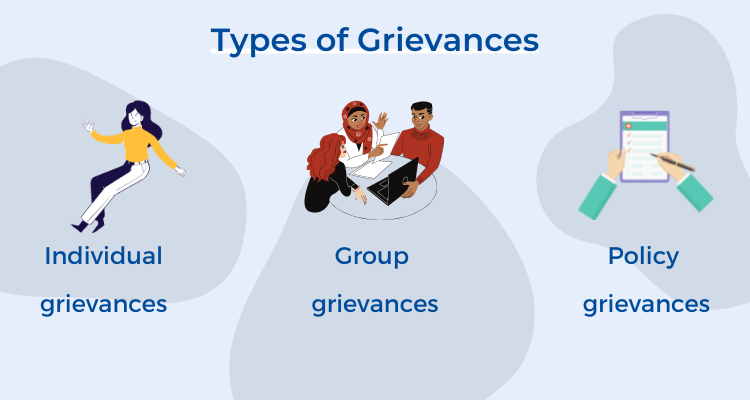What is a grievance
A grievance, by definition, is the real and or imagined wrong that causes one to file a complaint and or protest. In legal terms, it is the harm or cost that an individual suffers as a result of some action or inaction. The legal system has processes to address such disputes. For example, arbitration is in place to ensure that the suffering individual receives compensation.
Grievances in a workplace
In the workplace, grievances are complaints and protests that employees make in response to policies, decisions, and or conditions that managers and leaders make. Examples of grievances include unfair disciplinary action, negative changes in overtime policies, or late payments of benefits.
Grievances stem from actions or inaction that violate of one of the following:
- The employment contract
- The law
- Past practice
- Employees’ rights
Some organizations have grievance processes where employees can formally file a complaint. If you are an employee in a union, you can reach out to the union and they will file the complaint on your behalf. The purpose of these grievance processes is to settle disputes between employees and the employer. Additionally, they offer an opportunity for both parties to come to a resolution before going to arbitration.
The three types of grievances at work

In general, there are three different types of grievances. Below are the details of the different types of grievances and how they impact employees.
Individual Grievance
As an employee, you may experience wrongdoing that only impacts you. These usually come from actions or inactions from your supervisor. Some of the different types of individual grievances include:
Unnecessarily disciplinary action – if you’ve been disciplined by a superior and feel that it was unfair, you may have grounds for a grievance. Be sure to document the situation – capture what your behavior was, what your supervisor thought it was, and what the disciplinary action and reasoning are.
Demotion – If you experience a demotion, either formally with a title change, or informally, with your role and responsibility shrinking, you have grounds to file a complaint.
Harassment – if your managers are behaving in ways that are offensive and are harmful and the behavior would be seen as unwelcome by a reasonable person, you may file a harassment grievance. Examples of harassing behaviors include belittling and or humiliating an employee.
Denied Benefits – if employers are withholding benefits that are legally and or by policy available to you, you can file a grievance. This can be delay of payment for special tools or denial of health benefits.
Group Grievance
A group grievance is when an action or inaction affects several individuals. These individuals may be grouped by the fact that they are in the same department or are part of the same shift work. For example, if a manager tells a group of technologists that they can no longer work from home, all those in the group are affected. If their past practice is individuals can work from home for a reasonable amount of time, than a change in that practice can be seen as a grievance.
Policy Grievance
Policy grievances are similar to group grievances in that they are a grievance experienced by more than one individual. However, in policy grievances, the complaints are made by union. These complaints are a result of action or inaction by management in relation with something in the agreement.
Grievance processes at work
Many organizations have a grievance process that allows employees to formally file a complaint. This allows HR to log the employee’s feedback in response to a manager’s policy and decisions. Having a grievance process can be beneficial for the following reasons:
Formal feedback channel – having an effective grievance process ensures that employees feel heard and ultimately valued. When backed by leadership, it also promotes trust by encouraging employees to speak up without fear of retaliation.
Supports healthy work culture – grievance processes can also help prevent something small, like a change in work hours, from turning into something big. This will help leaders support the type of work culture and reduce toxic behaviors as necessary
Prevent litigation – a grievance process can also help prevent litigation by providing a channel for the employee and workplace to discuss and negotiate. Without this, employees may directly pursue legal routes, which can be costly and tarnish reputation.
Specificity in Employment Contracts – having a process at work will likely force the company to get specific with the employment contracts. This becomes very valuable because it communicates to employees what the expectations are.
Tips for companies managing grievance processes
Below are a few tips for businesses looking to implement a grievance process:
Employee Contract and Handbook – one way to mitigate potential grievances is by having strong policies and procedures and communicating them to employees. Document your grievance process in the handbook so it exists in writing. When onboarding new employees, distribute each of them the handbook and plan an exercise that gets the new employee to actively work through the handbook. Finally, train managers and seniors leaders on the processes to ensure they understand how their potential actions maybe handled.
Document, document, document – as an employee and even as a manager, you should always document, in detail, the grievances made. Have a standard grievance form that employees and or HR complete to initiate the complaint. Capture details around who is filing, their role, the event or action leading to the complaint. Also document any attempts to resolve the complaint.
Transparency through communication – a grievance process only works when employees trust that their complaint will be fairly dealt with. Thus, having clear communication of what the process is and keeping all parties up to date throughout the process is key for building this trust.
How to file a grievance
As an employee, you may experience a dispute or violation that drives you to want to file a grievance. With that, here are the key steps for filing a grievance.
- Speak to your supervisor first
In all cases, it is important to try and resolve the dispute first before filing a formal complaint. Simple miscommunications and or mismanaged expectations maybe resolved by talking with your supervisor. If having a conversation does not resolve the dispute, then move on to step 2. - File formal grievance in writing
To file a formal grievance, refer to any existing policy and procedures around your company’s grievance processes. If there is no formal process, reach out to your Human Resources department to formally file the complaint in writing. Be ready to provide specific details - Await Investigation
After filing a grievance, HR will launch and conduct a formal investigation. This entails interviewing employees and collecting evidence surrounding the event in complaint. If you suspect that the investigation will not be unbiased, you can opt to appoint an independent investigator. - Await the decision
When the investigation is complete, HR will notify the parties of the final decision. If you are unsatisfied with the decision, then gather more information for your position and appeal to more senior leadership. - Arbitration
Finally, if your company’s grievance process does not have an appeal process within it, you may opt to pursue your legal options. This will usually mean pursuing arbitration. In arbitration, an external judge will review and rule on the complaint.
Key takeaways
- A grievance is a real or imagined wrong that causes complaint or protest from employees.
- Companies should have grievance processes in place to provide a forum where employee’s can have their voices heard and to mitigate potential legal issues.
- For both employees and employers, make sure to always document the details of the grievance.
Related Readings
Professional Leadership Institute (PLI) is an educational website providing professionals from all types of businesses with practical education in entrepreneurial leadership. To keep evolving your leadership toolkit, additional PLI resources below will be useful:
- How to Apologize in the Workplace and Mean it
- How to be Assertive at Work
- What Does it Mean if I’m Always Bored at Work

